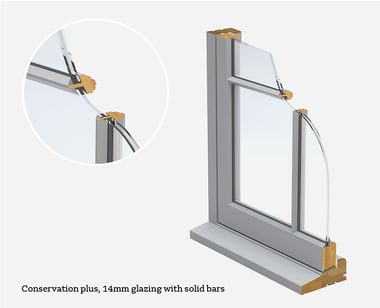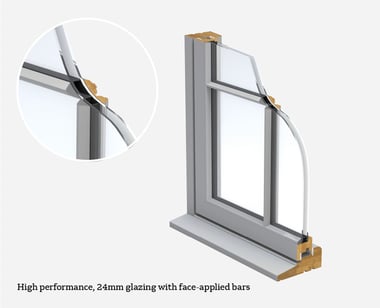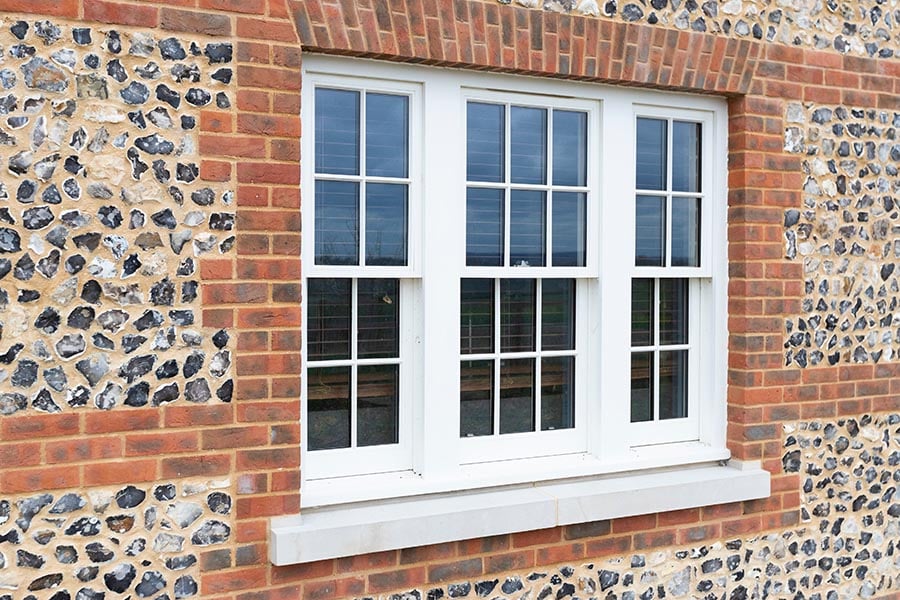In this blog we explore the role of glazing bars in window design and the merits of traditional solid bars or modern face-applied bars.
What is the difference?
Solid glazing bars are single pieces of timber fitted to a casement or sash frame into which glazing is fitted; when the window consisting of two or more glass panes. Face-applied or stick-on bars, are small sections of wood that are machined and configured to replicate glazing bar patterns. These are bonded onto the internal and external faces of the double glazing units, to give the appearance of solid glazing bars used in traditional windows. A window with face-applied bars will consist of a single pane of glass, with internal duplex bars at the positions of the glazing bars.
What is the history of glazing bars?
Solid bars were first introduced in the 17th Century to construct windows from multiple panes of glass. The glass was pinned into place using sprigs onto a bed of putty. As glazing improved and became lighter, thinner glazing bars were introduced including gothic and lambs tongue designs. When double glazing was introduced to improve energy efficiency in the 20th Century, windows increased in thickness, ranging from 14mm up to 40mm. Solid glazing bars therefore needed to be thicker to accommodate the double-glazed unit.
Face-applied bars were introduced, to allow slender designs sympathetic to historic periods to be produced, whilst delivering modern standards of energy efficiency through use of a single double-glazed unit. Their introduction also overcame problems associated with water ingress and durability.
What are the pros and cons of face-applied bars?
Cost
Solid glazing bars are more expensive for a number of reasons. Double glazing is normally ordered in a minimum square meterage, making multiple small units relatively expensive. Assembling the glazing bar framework with the casement / sash is more time consuming as there are more sections to fit. With solid bars, double glazing needs to be set into a rebate with enough timber left to form a joint and fix beading to it, so on standard double-glazing, solid bars can end up over 40mm thick. If you have a limited budget stick-on bars are the cheaper option.
Appearance
Solid bars are true to period window design and construction, so if your windows need to be 100% authentic to an original design or if the property is listed or subject to planning constraints, solid bars are likely to be the right choice . This might be complemented by Ovolo or lambs tongue mouldings typical of period designs. If you want face-applied bars on a conservation property that look identical to solid bars, you should consult the local planning authorities for consent.
Face-applied bars are the most popular option today. Many of our customers prefer their more slender and neater appearance, without the need for lots of beading. We also add duplex spacer bars in-between the double glazing on deeper units for a more authentic and premium look.


Durability
When using solid bars, drained and vented glazing is preferred which incorporates weep holes to allow water to drain away and keep a flow of air circulating around the glazing rebate. If puttied in, the windows may need additional regular maintenance to prevent water ingress into the frame that can lead to deterioration. The face-applied method allows water runoff without the need for a drained and vented system and with a single glass pane there are fewer joints to protect. Face-applied bars are stuck down with proprietary glazing tape with a very strong adhesion. We still advise to regularly clean windows with face-applied bars but for durability they come out on top.
Energy-efficiency
When fitted with low energy gas filled double glazing both methods are energy-efficient, however the energy U-value is significantly better for windows with face-applied bars. This is because the window consists of a single pane of glass rather than several panes you get with solid bars and the centre pane U-value proves it to be more thermally retentive.
How to choose from our window range?
At Salisbury Joinery we offer clients a choice of glazing bars and bespoke designs. Our Conservation Plus and Heritage range feature true solid bars for customers requiring this option. Other Sash Windows and Casement Windows in our range feature face-applied bars.






